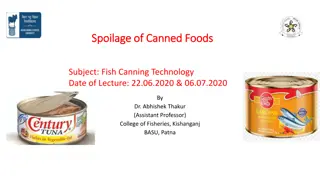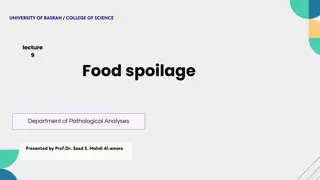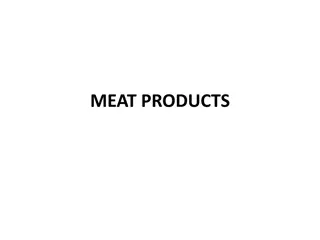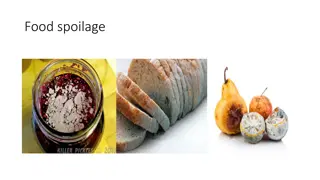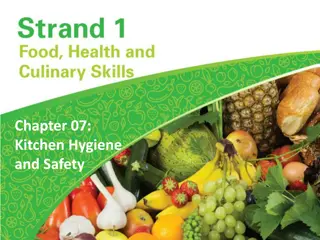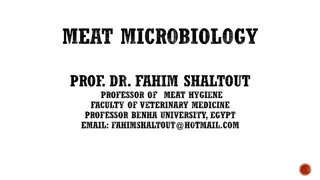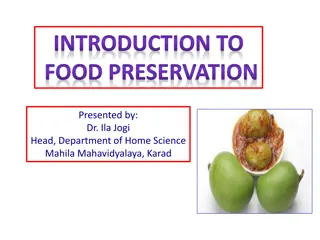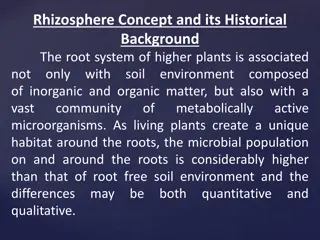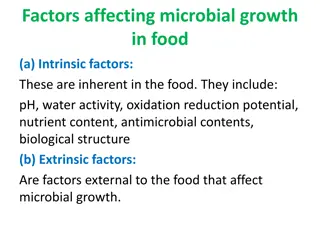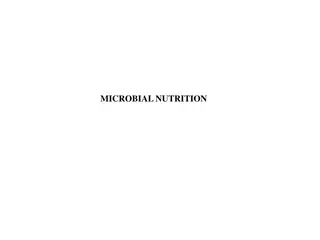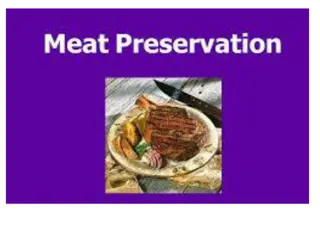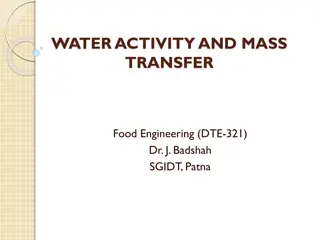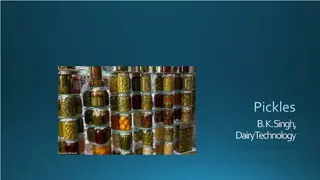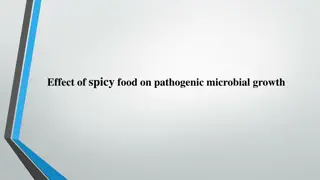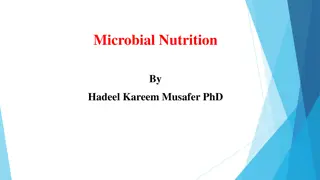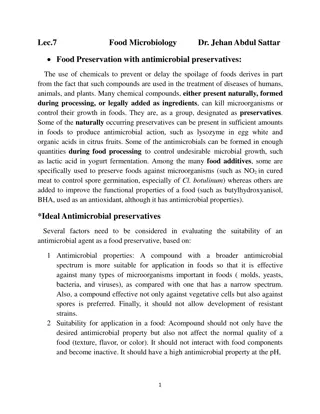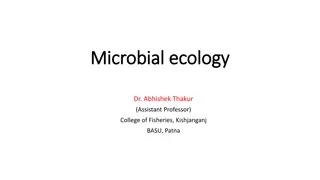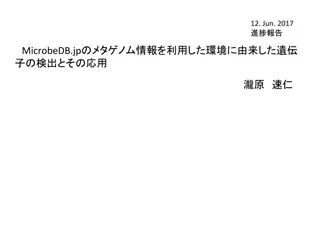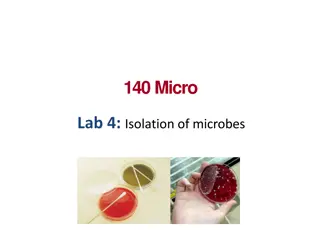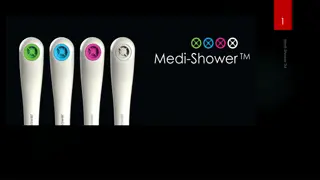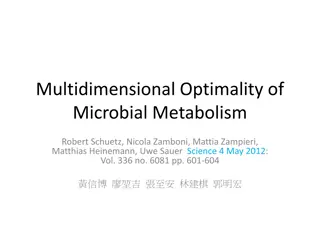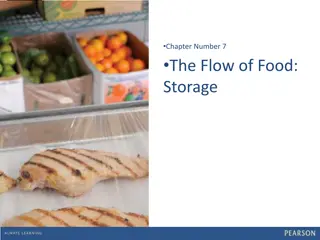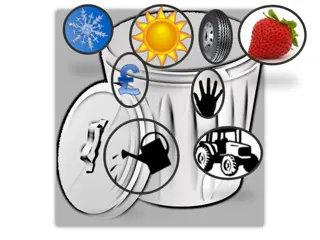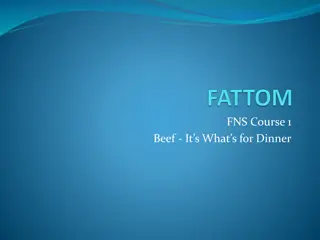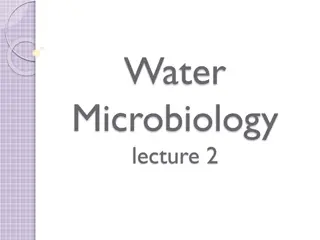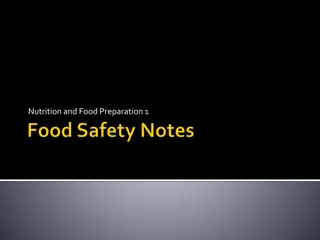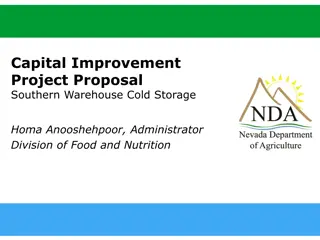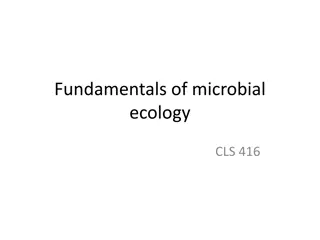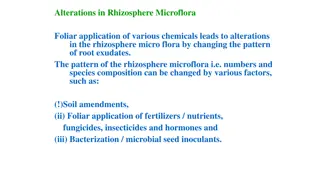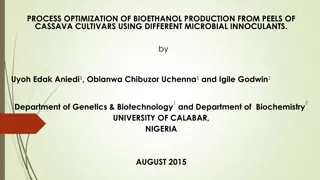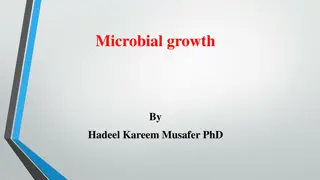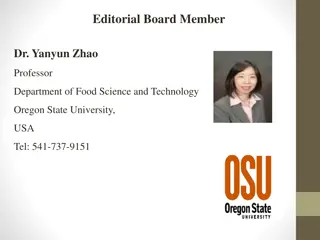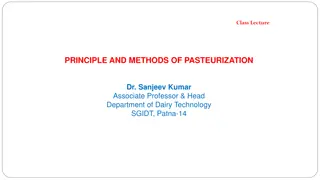Principles of Food Spoilage: Understanding Microbial and Nonmicrobial Factors
Explore the principles of food spoilage in the context of microbial and nonmicrobial influences. Topics covered include classification of foods based on stability, types of agents causing spoilage, prevention practices, and the criteria for acceptability of food. Learn about microbial growth, enzyme activity, and the various changes that indicate food spoilage. Gain insights into the decay and decomposition of food that renders it unacceptable to consumers.
Download Presentation

Please find below an Image/Link to download the presentation.
The content on the website is provided AS IS for your information and personal use only. It may not be sold, licensed, or shared on other websites without obtaining consent from the author. Download presentation by click this link. If you encounter any issues during the download, it is possible that the publisher has removed the file from their server.
E N D
Presentation Transcript
Food Microbiolog Fall 2018 LECTURE PRINCIPLES OF FOOD SPO LAGE
outline I.Introduction ii. Food Spoilage A. Classification of foods depending on stability B.Potentially hazard foods C. Types of agents causing food spoilage D. Microbial Food Spoilage E. Nonmicrobial Food spoilage Chemical Spoilage Non enzymatic food Spoilage F. Practices to prevent Food spoilage
Introduction for Principles of Food Spoilage Microbial growth can result with microbial food spoilage, desirable products or release of extracellular and intracellular enzymes. Spoilage can also occur due to action of microbial enzymes in the absence of the viable cells. Spoilage of different types of foods results with changes in color, odor, and texture, formation of slime, accumulation of gas and release of liquid(exudates, purge)
Food Spoilage Spoilage: Decay or decomposition of food which is not accepted by consumer. The criteria for acceptability of foods are; 1.the desired stage of maturity 2.Freedom from pollution 3.Freedom from objectionable biological, chemical and physical changes resulting from action of food enzymes; activity of microbes, insets and rodents, invasion of parasites, damages. 4.Freedom from m.o s and parasites causing foodborne illnesses.
Classification of Foods Depending on Stability 1. Highly perishable foods;If no preservation is applied, the quality retentian time is about 1-3 days. It incudes meat, poultry,fish,raw milk,eggs, many fruits and vegetables and all cooked foods except the dry and very acid ones. 2.Semiperishable foods;Lighty processed lsuch as pasteurization of milk and egg products and refrigerated. the quality retention time is about 1-3 weeks.Other examples frozen foods, baked goods, hard cheeses and fruits. 3.Semishelfstable foods;Two or more preservation process can be used (the hurdle concept) such as vacuum packaging the cooked meat products, the quality retention time is about 1-4 months. 4.Shelf stable foods(nonperishable foods)Highly processed (such as heat processed, sterilizes and hermetically sealed)such as vegetable , dried milk products with a qualty retention up to 1 year or more .Other examples are sugar, flour,dry foods, etc.
Potentially Hazard foods The following is the definition used in the FDA Food (a) "Potentially hazardous food" means a food that is natural or synthetic and that requires temperature control because it is in a form capable of supporting: (i) The rapid and progressive growth of infectious or toxigenic microorganisms; (ii) The growth and toxin production of Clostridium botulinum,; or (iii) In raw shell eggs, the growth of Salmonella Enteritidis (b) "Potentially hazardous food" includes an animal food (a food of animal origin) that is raw or heat-treated; a food of plant origin that is heat-treated or consists of raw seed sprouts; cut melons; and garlic-in- oil mixtures that are not modified in a way that results in mixtures that do not support growth as specified under Subparagraph (a) of this definition.
Potentially Hazard foods (c) "Potentially hazardous food" does not include: (i) An air-cooled hard-boiled egg with shell intact; (ii) A food with an awvalue of 0.85 or less; (iii) A food with a pH level of 4.6 or below when measured at 24 C (75 F); (iv) A food, in an unopened hermetically sealed container, that is commercially processed to achieve and maintain commercial sterility under conditions of non refrigerated storage and distribution; and (v) A food for which laboratory evidence demonstrates that the rapid and progressive growth of infectious or toxigenic microorganisms or the growth of S. enteritidis in eggs or C. botulinum can not occur, such as a food that has an awand a pH that are above the levels specified under Subparagraphs (c)(ii) and (iii) of this definition and that may contain a preservative, other barrier to the growth of microorganisms, or a combination of barriers that inhibit the growth of microorganisms. (vi) A food that does not support the growth of microorganisms as specified under Subparagraph (a) of this definition even though the food may contain an infectious or toxigenic microorganism or chemical or physical contaminant at a level sufficient to cause illness
Types of Agents Causing Food Spoilage 1. Growth activity of m.o s 2.Insects,rodents and animals 3.Action of enzymes 4.Purely chemical reactions in the food such as oxidation and browning 5.Physical changes caused by freezing,burning,drying, pressure,etc. 6. Presence of foreing material in the food such as heavy metals, toxins, non food materials and etc. 7.Presence of parasites or their eggs.
MicrobialFood Spoilage Microbial spoilage occurs as a result of microbial contamination with foods and activities of microorganisms under suitable conditions Factors Effecting Food Spoilage a)Kinds and numbers of m.o s in food b)Food residues c)Moisture content d)Time e)Temperature f)Physical state and structure of Food g)Significance of microbia types
2. Metabolism of Food nutrients and Chemical Changes a)Metabolism of nitrogenous compound B) Metabolism of non-nitrogenous compounds Carbohydrates Organic Acids Lipids Pectic substances Other compounds
Metabolism of Food nutrients and Chemical Changes a)Metabolism of nitrogenous compounds The nitrogen in foods is present in the form of proteins. Microbial extracellular proteinases hydrolyze proteins to polypeptide, simpler peptides and amino acids. Peptide give a bitter taste. catalysis the hydrolysis of polypeptides to simpler peptides and aminoacids. They can give desirable or undesirable flavor. Decomposition of proteins or aminoacids may result in the production of odors and is callded putrefaction.It results in foul-smelling,sulfur-containing products.These are hydrogen, methy and ethyl sulfides, mercaptan, ammonia,amines,indole and others.
a)Metabolism of non-nitrogenous compound mo s use carbohydates to obtain energy. Organic acids, aldehydes,ketones,alcolhols, glycosides,cyclic compounds and lipids are also used as carbon and energy sources. Carbohydrates: polysaccharides are hydrolyzed by extracellular enzymes and simple sugars are used. Glucose can be decomposed in 6 main fermentation.1)alcolholic ferm 2)Simple lactic ferm. 3)a mixed lactic ferm(heteroferm.) 4)coliform type ferm. 5)the propionic ferm 6)butyric-isopropyl ferm
a)Metabolism of non-nitrogenous compound Organic acids; m.o oxidase organic acids to carbohydrates and medium become more alkaline. Some mo s can oxidase organic acids to CO2 and water such as yeast(film on pickle) Lipids; Fats hydrolyzed to glycerol and fatty acids. Phospholipids can degraded to phosphate, glycerol, fatty acids, nitrogenous base. Lipoproteins can be hydrolyzed to proteins, cholesterol ester and phospholipids. Other compounds; alcohols are oxidized to organic acids acetaldeydes may be oxidized to acetic acid or ethanol.
E)Nonmicrobial Food Spoilage 1.Chemical spoilage -The Maillard reaction occurs between a carbonyl compound like a reducing sugar, and an amine, like an amino acid, peptide, or protein. -lipid oxidation Examples: repetitive usage of frying oils in restaurants, odor becomes heavy. Discoloration of surface of red meat is caused by non enzymatic reactions, oxidation of myoglobin to metmygoglobin
Preference for metabolism mo use carbohydrates first, fallowed by NPN and proteinaceous compounds and lipids. Small nutrient molecules are used before the large molecules. (For ex: yeast growing in fruit juice cam metabolize simple carboydrates such us fructose, glucose and sucrose) Type of nutrients can effect types of spoilage in foods. For ex: meats with low level of carbohydrates are spoiled by putrefactive m.o s.
Nonmicrobial Food Spoilage 2. Enzymatic spoilage The enzymes on banana cause maturation and color changes Ripening and softening fruits Bacteria also produce enzymes Enzymes in vegetable can be inactivated by blanching or their activities can be decreased at cold temperatures below 4 C.
F)Practices to prevent Food Spoilage Package the fresh product Use the best packaging material for length of time the food remains in the market channel. Use good sanitation and personal hygiene habits during processing and packaging of food. Use sanitation habits for equipment used in the food production. Cool processed foods as quickly as possible to below 4 C. Keep left over foods covered to prevent contamination and put them under refrigeration as soon as possible. Keep hot food on steam table above 60 C . Cool the foods in large containerrs containing ice. Cook food up to an internal temperature of 75 C to destroy both enzymes and vegetative bacterial cells. Type of packaging material should be considered carefully to control food spoilage.


